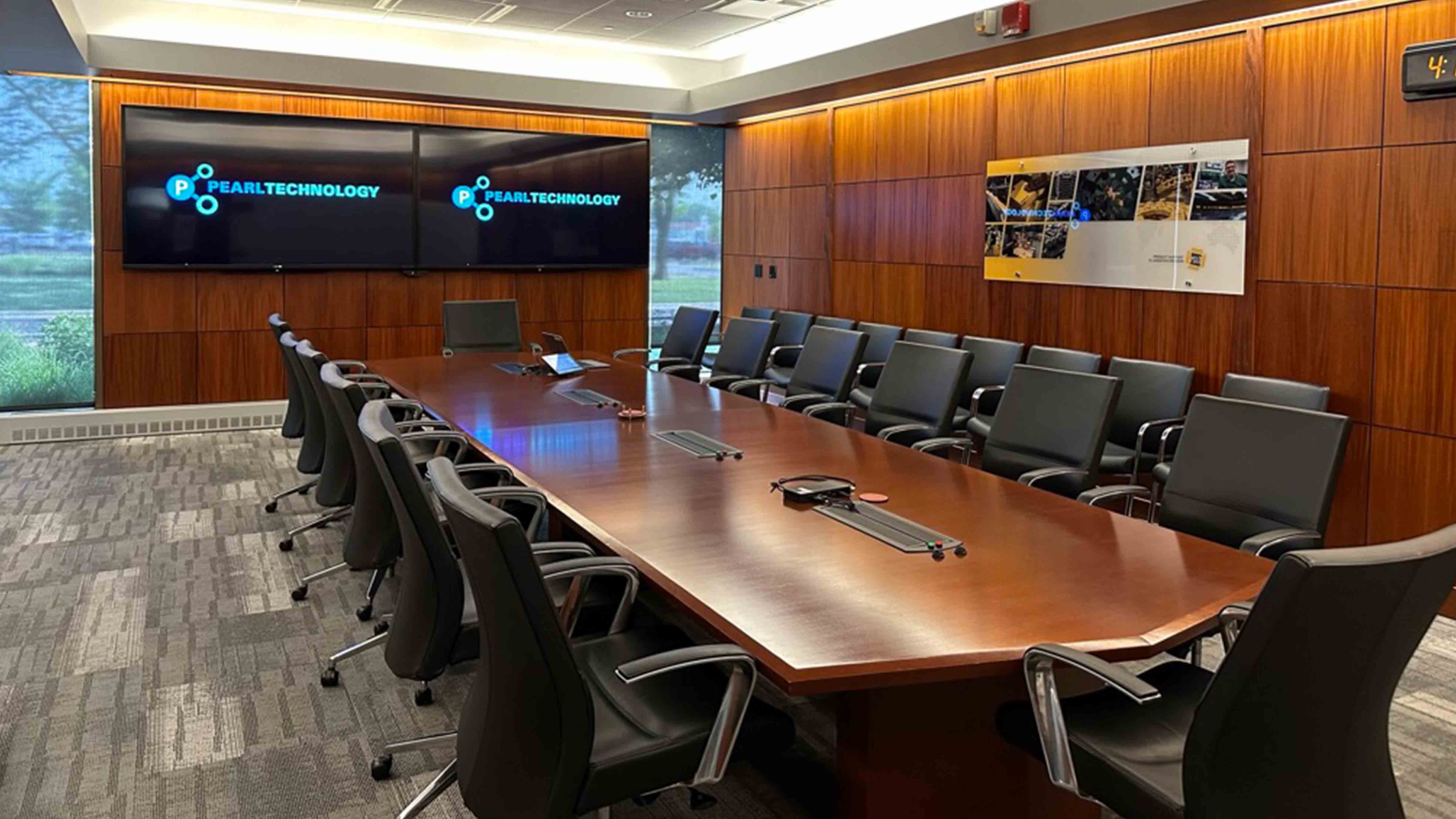There is a lot of talk about the need for professionals in every industry to embrace uncertainty. But while rapid change sweeps across the globe, those working in Pro AV can be sure of a few things: AI will continue to gain prevalence, hybrid is here to stay—no matter how many organizations attempt to force their employees back into the office—and there is still room for improvement in making these gatherings equitable. As 2024 comes to a close, SCN reached out to industry experts from equipment manufacturers and systems integrators to gain some insights on these trends (and a few others).
Real Talk on Real Estate

Good design produces spaces that accommodate how people collaborate, learn, and even shop. Julian Phillips, senior vice president of global workspace solutions and managing director of XTG at AVI-SPL, argues that AI’s ability to capture rich data can contribute to providing better, more valuable experiences for corporate employees, students, retailers, and consumers.
“We cannot design dumb spaces anymore,” Phillips said. “If we want to take advantage of everything AI can do to help us analyze this rich data, to get insights into it—to improve and unlock productivity—we have to have a reliable, constant, verifiable source of rich data. That means that everything we do in space and environment has to be captured, and we have to be able to use that data to great effect.”

Beyond traditional smart building analytics that focus on electricity usage and HVAC control, Phillips believes in AI’s capacity for delivering observational data. What is going on in the space? Where are people sitting? Are they moving around? How are they presenting? How are they collaborating? In other words, what are they doing?
For organizations to successfully optimize their real estate, they need to know how their current facilities are being used. This is where monitoring can play a valuable role, according to Simon Watson, global head of innovation at Kinly.
[Viewpoint: Evaluating the Office Space Identity Crisis]
“A lot of companies say, 'We’re going to split our office in half.' But what’s going to be the effect of that? Do you know how busy your office is at the moment?” he offered.
Phillips acknowledged that privacy laws and regulations limit how and what data organizations may gather, but he argued that shouldn’t be an excuse to continue doing things the old way. “If [people] do want to make use of this new era of technology, they have to start taking data seriously,” he said.
With monitoring, companies can gain better insight into how many people are in the office—and where they are on campus. That data can better inform decision-making on what the smaller, redesigned space should accommodate. “That’s where monitoring of the real estate comes in because you need tangible output to make those decisions," Watson added.

In Northern California, where the digital media, entertainment, and broadcast engineering firm Advanced Systems Group is headquartered, ASG president Dave Van Hoy has observed a focus on the reduction of corporate real estate. For example, technology companies in Silicon Valley are consolidating their campuses by moving into newer facilities and closing their old buildings, which has led to less demand for outfitting conferencing spaces.
“There is a very large amount of that going on right now, which means that if you look at the systems integrator business, it’s probably not a great sign,” Van Hoy said.
However, at the same time, Van Hoy said the corporate broadcast production business is solid. The lesson here is that AV companies that concentrate on diversifying their revenue stream are better positioned to accommodate market fluctuations.
“The diversification of your client base is always important, whether you make it through geographical diversity, whether you make it through line-of-business diversity,” Van Hoy said. “That is what 2025 is going to be about. We’re going to see some markets shift up, [and] some parts of the market shift down. It’s going to be about understanding what you’re good at and not good at, and where you can be to maximize the situation.”
Better Business and Audio

AI is also improving the audio experience for remote and hybrid meetings. No longer are participants bothered by the proverbial crackling chip bag or barking dog off in the distance. Tyler Troutman, strategic market development manager at Shure, noted that AI also helps strike the balance between achieving great sound while rolling out systems as fast as possible.
“We end up with a little bit of a competing narrative where we want to deploy more rooms with better quality audio at a quicker pace,” Troutman said. “That is where AI steps in and helps us out. It helps us deploy quicker with more repeatable, accurate results—and then deliver fantastic audio.”
It’s not enough for AV professionals to limit AI adoption to customer-facing applications. There are significant opportunities to take advantage of these tools to drive efficiency in AV design and integration firms themselves.
AVI-SPL is establishing an AI Center of Excellence that brings together business groups across the organization to determine the best internal use cases for AI. Phillips described it as a sandbox of sorts, a venue that encourages people to experiment with the technology. He said the goal isn’t to eliminate people, but to identify the repetitive tasks that AI could perform so the organization’s human talent can focus on more sophisticated, higher-level tasks.
“When we start turning AI internally on ourselves, we can start looking at ways that we can unlock efficiencies and cost reduction.”
Julian Phillips, AVI-SPL
“When we start turning AI internally on ourselves, we can start looking at ways that we can unlock efficiencies and cost reduction,” Phillips added. “It’s going to create a healthier industry that’s going to enable us to invest more in the kinds of things that we should be doing.”
For example, ASG is using AI to optimize statement of work (SOW) and contract generation. “Its ability to create much better templates, if your model is trained well, is insane,” explained Van Hoy. “The first thing people say is, 'This is going to get rid of people’s jobs.' I don’t believe that for a minute. I’ll tell you one thing that’s for sure, though: I still have the same number of people, but boy do they turn out better stuff using that tool.”
Opportunity to Improve





Advancements in camera technology have enabled AV designers and integrators to provide better collaborative experiences, acknowledged John Bailey, senior VP of technology and innovation at AVI-SPL. Now what needs to improve are the displays in these spaces.
“It’s still the panel of glass on the wall at the end of the room that everybody refers to,” he said. “It’s not working well for video and virtual presence.”
Instead, Bailey suggested the need to position more displays on multiple walls—or maybe even on the conference table itself. “There is a lot we can explore there," he noted, "and we need to be open-minded about different experiences."
Holli Hulett, co-founder and COO of Boom Collaboration, said that for meeting equity to be possible, at the bare minimum, organizations need high-quality AV systems. "Facilitating simple things like being able to make eye contact, read body language, hear the intonation of words along with all of the words—those are some of the first components that have to exist to even begin discussing equity,” she explained. “Are we there yet? I don’t think so. I think we’re getting better.”
Jeremy Caldera, EVP at AV design and integration firm Pearl Technology, argued that the term “meeting equity” means different things to different organizations. Some may be focused on creating the same experience for both on-site and remote meeting participants, while others may be concerned about delivering a good experience in multiple languages.
Plus, creating equitable meeting spaces—featuring multiple camera angles, high-quality audio, and production-style switching—is hard to do at scale. “I don’t know if that is going to happen,” Caldera admitted. “People are still watching their budgets.”
For Garth Lobban, director of marketing at Atlona, audio is becoming more important than video in meeting and learning spaces. For hybrid gatherings to be truly equitable, remote participants need to be able to hear what is being said on site, and in-person collaborators shouldn’t have trouble hearing colleagues who are contributing virtually. This requires quality audio systems and good acoustics.
“What are we doing to make it easier for the audio DSPs that are built into Google, Teams, and Zoom?” Lobban asked. “If [I’m] in a reverberant space where there are lots of echoes, now it’s got to try to get all those reflections off my voice. We can make those systems work [better] if we can make sure that the rooms are well-treated.”
[SCN Hybrid World: Out of Sight Sound]
A vast majority of meeting spaces feature a BYOD element, observed Fredrik Hornkvist, co-founder and CEO of Boom Collaboration. This is what has driven his organization to develop technology that enables users to take advantage of installed, in-room systems while using their own devices.
“We’re combining some of the hardware endpoints that have AI functionality with a bring your own device use case,” Hornkvist said. “We want to strike a balance [so] that you can have both—you can have the familiarity of using your own device and leverage that with AI-driven equipment, without having to lock down on a high-end AI solution that might be proprietary to one platform.”
Cloud Management Migration

Remote monitoring and management are nothing new, but its migration to the cloud has streamlined scalability. It facilitates the management of multiple sites and offers deeper control, observed Naurry Kwon, product manager at Planar. The result: IT organizations are more efficient. "Cloud monitoring solutions are bypassing the need for full IT teams to setup and maintain the network and application structure," Kwon said.
One issue with some monitoring systems is that they are device-specific: one platform monitors displays, another looks after cameras, etc. According to Kwon, technology developers are addressing this, and some integrators are creating tools that bring different systems under one umbrella. "What we’re seeing is more collaboration across different types of equipment or solutions where possible, with some platforms offering the capability to integrate with a range of AV devices,” he said.
[Making the Case for Managed Services]
At Pearl Technology, Caldera explained that while cloud monitoring reduces truck rolls—which in turn decreases the need to pull valuable talent off projects in progress to perform on-site troubleshooting—not all clients are willing to migrate systems to the cloud. His Fortune 100 customers are an example of this.

“[For these clients,] we put all of our systems on closed networks—they’re not allowed to touch the internet, so I can’t cloud monitor anything,” Caldera said. “It’s too much of a security risk, and these days that’s huge.”
With cybersecurity a primary focus for enterprise-level organizations, Caldera believes that an increasing number of clients will include stipulations in their master service agreements that require AV integrators to comply with recognized cybersecurity standards. Not only do these companies want to protect their data and that of their customers, their cybersecurity insurance policies require them to uphold a certain level of security hygiene. This is why Caldera urges his peers to keep security top-of-mind.
“I don’t want one of my pieces of AV gear to be responsible for the takedown of an entire Fortune 100 corporation,” he said. “You don’t want to be the responsible party. And it’s not just the Fortune 100s that are being targeted. It’s the church. It’s my kid’s school. There needs to be some major adoption [of security best practices] from the AV industry.”
